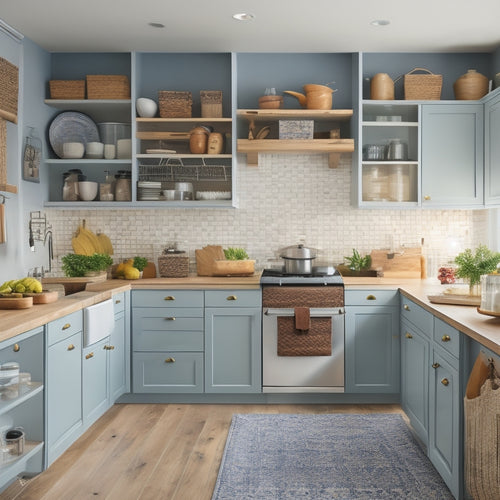
3 Essential Kitchen Hacks for Home Chefs
Share
You can supercharge your kitchen's productivity by implementing three essential hacks. First, optimize your storage space by utilizing vertical areas, installing corner shelves, and incorporating spice carousels. Next, streamline your meal prep process by planning meals, adopting batch cooking, and prep-cooking entire meals on weekends. Finally, master your kitchen's workflow efficiency by identifying and optimizing prep, cooking, and cleanup zones, prioritizing tasks, and eliminating bottlenecks. By applying these hacks, you'll cook faster, smarter, and with more free time. Now, take your kitchen to the next level by exploring more tailored solutions for your unique space.
Key Takeaways
• Maximize kitchen storage by utilizing vertical space, installing corner shelves, and incorporating compact spice carousels.
• Streamline meal prep by planning meals, adopting batch cooking, and prep-cooking entire meals on weekends for quick reheating.
• Optimize kitchen workflow by identifying and optimizing zones, prioritizing tasks, and implementing time blocking to schedule tasks effectively.
• Customize storage solutions to fit unique kitchen dimensions, keeping special occasion dishes and cookbooks accessible but out of the way.
• Eliminate bottlenecks and streamline workflow by understanding zone requirements and optimizing the physical layout for easy access to utensils and ingredients.
Optimizing Kitchen Storage Space
By strategically allocating your kitchen's vertical space, you can maximize storage capacity and reduce clutter, creating a more efficient and organized cooking environment.
One effective way to do this is by installing corner shelves, which can be custom-fit to your kitchen's unique dimensions. These shelves provide ample storage for infrequently used items, such as special occasion dishes or cookbooks, keeping them out of the way but still accessible.
Another space-saving solution is the incorporation of spice carousels, which can be mounted on a wall or placed on a countertop. These rotating units allow you to store a large number of spices in a compact area, making it easy to find the one you need at a glance.
Streamlining Meal Prep Process
With your kitchen storage optimized, you can now turn your attention to streamlining the meal prep process, where every minute counts and efficiency is key. By implementing a few simple strategies, you'll be able to cook like a pro and enjoy more free time.
First, start by planning your meals for the week. This will help you create a grocery list, avoid food waste, and make sure you're cooking what you need.
Next, adopt batch cooking as a habit. Cooking large quantities of a single ingredient, such as rice or beans, can save you hours of time in the long run. You can then use these ingredients to whip up quick and easy meals throughout the week.
Additionally, consider prep-cooking entire meals on the weekends, and reheating them as needed. By doing so, you'll be able to enjoy healthy, home-cooked meals without sacrificing precious time during the week.
Mastering Kitchen Workflow Efficiency
To maximize kitchen workflow efficiency, you'll need to identify and optimize the three primary workflow zones: food preparation, cooking, and cleanup, as each zone has its unique set of challenges and opportunities for streamlining. By understanding the specific tasks and requirements of each zone, you can eliminate bottlenecks and optimize your workflow.
Effective task prioritization is essential in kitchen workflow efficiency. Identify the most critical tasks that require your attention and allocate them to the most productive time slots. Use time blocking to schedule specific tasks to specific time intervals, making sure that you're dedicating sufficient time to each task. This approach enables you to tackle complex tasks during peak energy levels and delegate simpler tasks to less demanding periods.
Additionally, consider the physical layout of your kitchen and optimize it for workflow efficiency. Make sure that frequently used utensils and ingredients are easily accessible, and that your workflow moves in a logical sequence.
Frequently Asked Questions
How Do I Prevent Kitchen Utensils From Rusting Over Time?
To prevent kitchen utensils from rusting, you'll want to dry them thoroughly after washing, apply a thin layer of oil, and store them in a dry place, ensuring rust prevention through proper utensil maintenance.
Can I Use Aluminum Foil in the Microwave Safely?
"As you stand before the humming microwave, foil in hand, remember: you're playing with fire. For safe microwaving, use thin, smooth aluminum foil, avoiding crinkled or thick sheets that can spark a blaze, ensuring microwave safety in every cook cycle."
What's the Best Way to Clean Between Keyboard Keys?
You'll master keycap maintenance by using compressed air to gently blow out debris, then dampening a cotton swab to wipe down keys, and finally, employing a can of electronics cleaning solution for thorough dust removal.
How Often Should I Replace My Kitchen Cutting Boards?
"When you're stuck between a rock and a hard place, it's time to reassess your kitchen habits. You should replace your cutting boards every 1-3 months, depending on usage and material, and prioritize board sanitizing to prevent cross-contamination."
Can I Revive Stale Spices to Regain Their Flavor?
You can revive stale spices by implementing a spice rotation, storing them in a cool, dark place, and toasting them lightly to regain their flavor; this flavor boost will refresh your dishes.
Related Posts
-

Mastering Kitchen Organization: 7 Expert Tips Inside
You're just a few simple strategies away from transforming your kitchen into a highly functional and efficient space ...
